Page authority is a metric that predicts how well a specific page might rank on search engines. SEOs use it to evaluate ranking potential, compare pages, and plan link-building strategies. The higher your score, the more likely your page is to rank, at least in theory.
In this guide, I’ll break down what page authority means, how it’s calculated, and how to improve it with actionable steps.
What you will learn:
- What page authority is and how to measure it
- How page authority compares to domain authority
- 5 tips to improve your page authority with examples
What is page authority?
Page Authority (PA) is a score that predicts how likely a specific page is to rank in search engine results.
The score ranges from 1 to 100. A higher score generally suggests stronger ranking potential. But the way the scale works isn’t linear. It’s logarithmic. That means moving a page from 20 to 30 is much easier than moving it from 70 to 80.
Page authority is based primarily on link-related signals, including the number of backlinks, linking domains, and the overall quality of those links. It helps you understand how a page stacks up against similar content in terms of authority.
The concept was first introduced by Moz, which developed the original PA metric. Other tools now offer their own versions. For example, Ahrefs uses a similar score called URL Rating (UR). These scores are often used interchangeably, even though their calculation methods differ slightly.
Keep in mind—this score applies to a single URL, not your entire website.
Why should you measure page authority?
You should measure page authority to understand how well a page is positioned to rank compared to others targeting the same topic.
It helps you spot which pages might need more work, and which ones already have authority you can build on.
Tracking changes in your page authority score can also show whether your recent updates are helping. If the score goes up after a round of link-building or on-page tweaks, that’s a clear signal your strategy is working.
It also helps when you’re analyzing backlink opportunities. A link from a page with high page authority will likely pass more value to your site than one from a low-authority source.
For example, you can see the differing page URL ratings for these search results.
This makes it easier to prioritize which pages you want links from. Especially if your goal is to improve both your page performance and your domain authority.
Even slight differences in page authority scores can guide your next steps. You’ll quickly see where you’re falling behind and where you’re gaining ground.
How is page authority calculated?
Page authority is calculated by weighing the quality and quantity of referring links pointing to a specific page.
It’s a link-centric metric, so backlinks carry the most weight. The score considers varieties of signals tied to the page’s link profile, including:
Here are some of the key factors that influence a page's authority score:
- Linking URLs and root domains: More unique domains linking to your page usually boost its authority.
- Follow and no-follow links: Followed links carry more weight, but no-follows are still part of the overall profile.
- Anchor text distribution: Relevant and natural anchor text can strengthen a link’s impact.
- Status codes like 301 and 302: Redirected pages pass link equity differently, which affects how authority flows.
- New vs. old links: Fresh links can boost authority, but long-standing backlinks from trusted sites still hold strong value.
The exact formula behind page authority isn’t publicly available. Like most SEO metrics, it’s built on proprietary data and weighting systems that aren’t disclosed.
What’s the difference between page authority and domain authority?
The main difference between page and domain authority is that page authority assesses ranking potential at page level while domain authority measures a website’s ability to rank in search results.
Domain authority looks at the strength of the whole domain. It factors in all indexed pages, total inbound links, and the authority of those linking sources.
Page authority focuses solely on an individual page. It helps estimate how likely that page is to rank, even if the rest of the website has low authority.
Both scores use similar signals like referring domains, link quality, and anchor text but apply them at different levels.
In the next section, we’ll look at whether page authority plays a direct role in Google’s ranking algorithm or if it’s simply a third-party benchmark used for planning and analysis.
Is page authority a Google ranking factor?
No, page authority is not considered a Google ranking factor because it is a third-party metric developed by SEOs to understand how Google's algorithm ranks pages.
“In general, Google doesn’t evaluate a site’s authority. So it’s not something where we would give you a score on authority and say this is the general score for authority on your website. That’s not something we would be applying here.”
That said, page authority is still useful.
It’s a predictive metric. It analyzes the link signals that often correlate with better rankings, like the number and quality of inbound links pointing to a specific page.
Because of that, many SEOs use page authority to compare pages, evaluate link opportunities, and decide which content to prioritize.
But it’s important to keep perspective.
A high page authority score doesn’t guarantee that a page will rank. And a lower score doesn’t mean the page can’t perform well—especially if other ranking factors are strong.
Use page authority as a guide, not a rule. It works best when you use it to benchmark pages, spot SEO opportunities, and refine your strategy based on competitive data.
How to check your page’s authority
You should check your page authority by using tools that measure the strength of your page based on backlinks and other link signals.
Since Moz introduced page authority, the easiest way to check it is through Moz’s Link Explorer.
Enter your page URL, and the tool will display your current page authority score along with metrics like linking domains, inbound links, and domain authority.
You can also install MozBar, a free Chrome extension. It shows the page authority and domain authority of each result directly on the search engine result page.
If you’re comparing competitors or sizing up link opportunities, MozBar makes it easier to do it at a glance.

Other SEO platforms provide similar metrics.
For example, Semrush offers an authority score. It works in a comparable way by estimating the overall strength of a page based on link signals and other ranking factors.
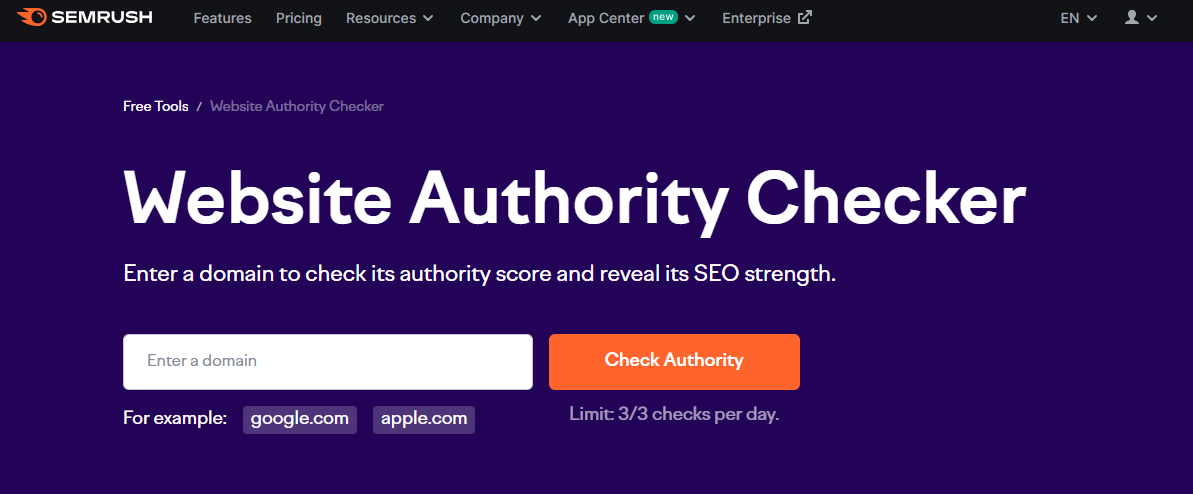
These tools can also help you check your domain authority measures. And it also gives you a broader look at how your entire website is performing.
5 tips for improving your page authority quickly
Improving page authority doesn’t happen instantly, but a few focused actions can help move the needle faster. Most of what affects a page authority score comes down to backlinks and overall content quality. That means even small changes can improve rankings if the page already has some authority.
So let's go through five practical tips to help you increase your page authority score.
1. Improve your backlink profile
The most direct way to improve page authority is to earn better backlinks. I don’t mean more links. I mean stronger, more relevant ones.
Page authority is a link-based metric. It increases when a specific page gets backlinks from other trusted pages. But that only works if the referring pages are credible and closely related to your topic.
Start with a backlink audit.
Use a tool like Moz’s Link Explorer, Ahrefs, or Semrush to see which websites are linking to your page. Segment them by authority. This helps you identify which links are likely helping you move the needle and which ones may carry little to no value.
Once you know where you stand, focus on opportunities to build high-authority links to the page you want to improve. Use these tactics to build high-quality links to the page you want to improve:
Guest post on industry blogs that accept contextual links
Guest posting is still one of the most effective ways to earn high-quality backlinks, especially if you’re writing for sites that rank well and cover topics close to yours.
Start by identifying websites that already link to your content. These domains are familiar with your work and have shown interest by linking to it. They’re more likely to accept a guest post pitch or another type of collaboration.
Once you’ve exhausted that list, expand your outreach to blogs in your niche that regularly publish external contributions.
Prioritize those with decent domain authority and an engaged audience that overlaps with yours. These don’t have to be huge publications. Just credible sites your readers already trust.
The link should appear within the article and use anchor text that naturally aligns with your target page.
But there’s some legwork involved. You’ll need to pitch topics they haven’t already covered, research their voice, and deliver good content. Most editors can spot link dumps from a mile away.
If you want to scale the process, SEO agencies can help. Many offer guest posting as a service and already have relationships with relevant blogs. Just know that you’ll have less control over where the content goes, and these services usually come at a higher cost.
Publish data or insights people want to cite
Original data is one of the most powerful link magnets.
Content marketers, journalists, and bloggers constantly look for sources to support their claims. If you can be that source, your page becomes much more linkable.
You don’t need to run a massive study. Even small surveys or internal data when visualized well and tied to a broader topic can earn dozens of links over time.
Take this State of AI survey report from McKinsey as an example.

It generated 3600 backlinks, as shown below.

The only catch is that this content can take time to create. It also needs to stay updated. But once it earns links, you can keep them by refreshing the data yearly without changing the URL.
Replace broken links with your content
Outdated links slip through the cracks all the time. If you can spot them and offer a better, up-to-date resource, most site owners are happy to swap it in, and you get the backlink.
Here’s how I approach the broken link building process:
Start by finding websites in your niche that are linking to outdated tools, expired offers, or discontinued products. You can do this using Ahrefs or Semrush. Both platforms let you spot outbound links that return a 404 or redirect.
But not all outdated links are broken. Some still point to live pages, just with misleading or outdated information.
Take Dropbox, for example. This blog post still claims that Dropbox offers up to 18 GB of free storage through referrals. But Dropbox’s help page shows the actual cap is 16 GB, and that’s only if users refer 32 people (500 MB per referral).
If you’ve built a genuinely free alternative or created an up-to-date guide comparing storage tools, you can use that as your angle.
Here’s what that pitch might look like:
“Hi, I noticed your post lists Dropbox as a top free cloud storage tool. Dropbox’s free plan is now just 2 GB, and even with referrals, users max out at 16 GB. Most people need more space. Would you consider updating your list to include [your tool or guide] as a more current option?”
Not every opportunity will be worth your time. Some outbound links lead to sites that haven’t been updated in years. Skip those. Focus on live, maintained sites with real traffic. Those are the ones that pass meaningful link equity.
2. Publish valuable content
The kind of content you publish has a direct impact on your ability to earn backlinks and, as a result, improve your page authority score.
If your content isn’t worth linking to, it won’t matter how many outreach emails you send. People link to pages that offer something useful, original, or convenient to reference.
So before anything else, ask: Is this content genuinely helpful?
Use existing search results to guide your structure
Start by Googling your target keyword.
Scan the results and look for websites that are in the same authority range as yours. You can ignore outliers like Wikipedia, Forbes, or Healthline. These sites rank because of their massive authority, not necessarily because their content is better.
Instead, see if smaller or mid-sized websites that match your authority score are ranking.
For example, if you’re an AI design SaaS, publishing a blog post on “color theory” will likely not break into the top search results because of the influx of authority websites already present.
But a topic like “UX and web design” shows less authoritative websites ranking on the first page of Google, alongside some popular names.
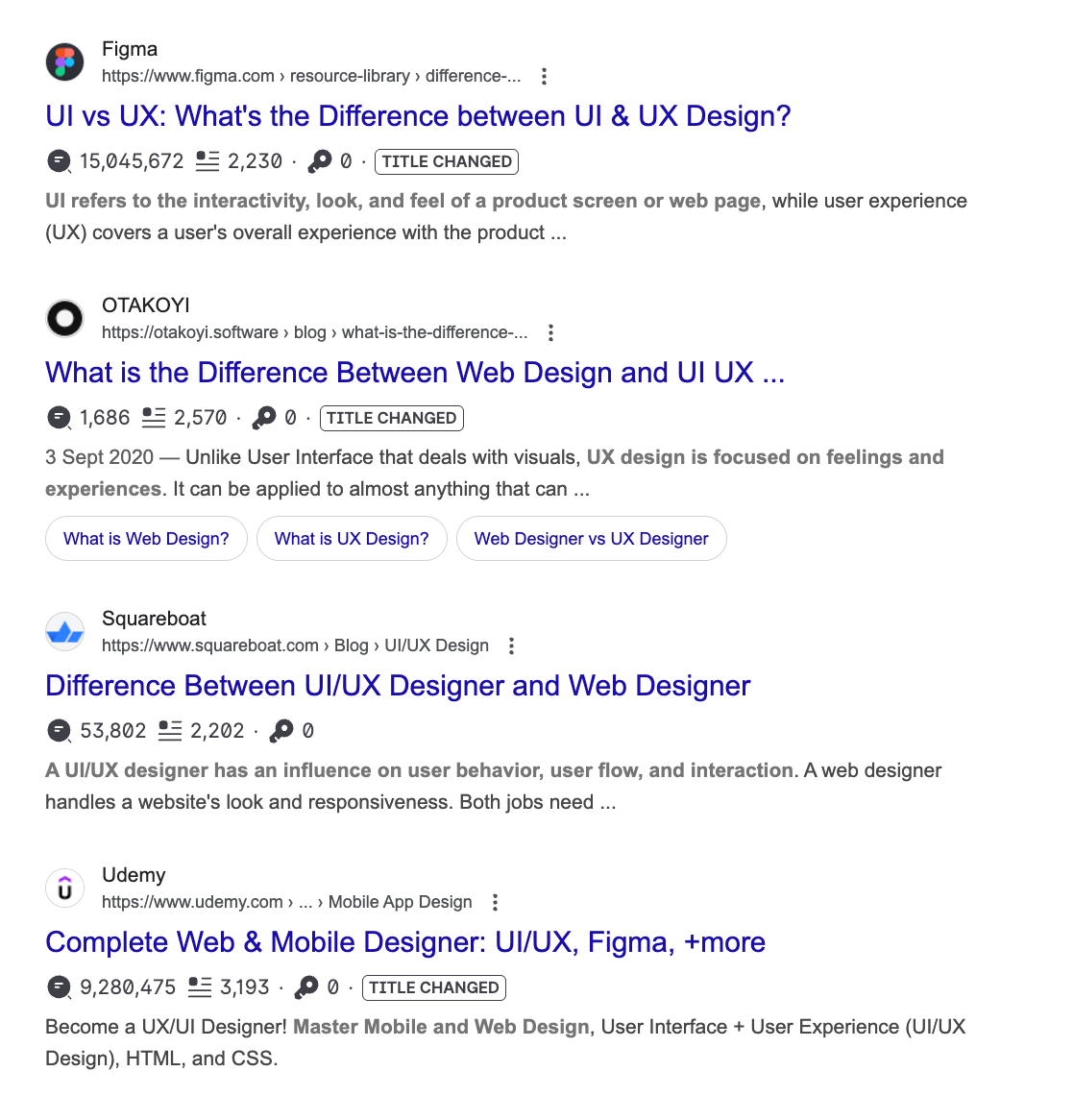
Choose topics that you have a better chance of showing up for.
Open pages that are already ranking and study what they include:
- How subheadings are structured (e.g., ingredients, instructions, tips)
- If visuals are used (step-by-step photos, printable cards)
- Whether they include FAQs or schema markup
- What kinds of backlinks they’ve earned
This quick scan gives you a real sense of what kind of content works for your tier.
Prioritize formats that naturally earn backlinks
Certain types of content consistently get more backlinks, especially when they offer something people can reference, reuse, or rely on.
Original research
If you can publish new data or insights, people will reference your content. Nearly 47% of marketers already include original research in their strategy because it works.
It works best when you focus on topics people are actively discussing or debating.
For example, Zyppy ran a study analyzing how often Google rewrites page title tags. The headline was simple but clear: “Google Rewrites 61% of Page Title Tags.” It was published as a detailed SEO study and updated in 2023.
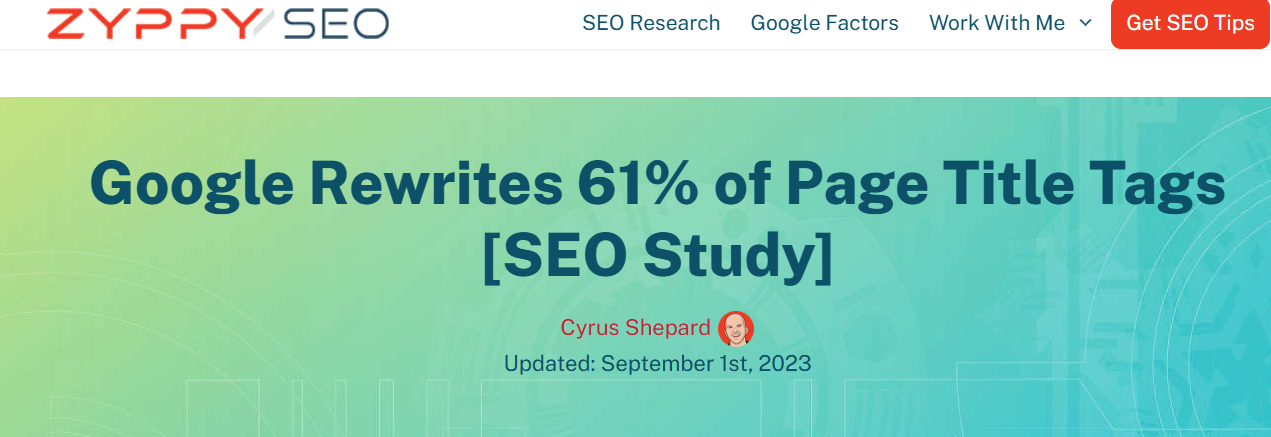
The result? The study earned backlinks from over 300 referring domains. It’s now Zyppy’s most linked page after the homepage.
Original research gives people a reason to link to you. Just make sure it’s easy to cite. Use tables, charts, and direct stats that people can quote or embed in their posts.
Case study roundup
Compiling multiple stats or examples into one page gives other creators a convenient resource to link to.
A good roundup makes research easier for everyone else. An example is Tomislav Horvat, who published 18 stats-based articles and two case-study compilations.
Without running active outreach, those posts earned him 308 backlinks from 215 different domains, including sites like Neil Patel and Synthesia. He organized data well and published consistently over time.

Expert roundup
Expert roundups are sometimes used to build backlinks, but results depend on how the content is created. Simply featuring multiple contributors doesn’t lead to shares or links. The topic, format, and clarity all matter.
If the topic is timely and the expert quotes are thoughtful, the article becomes more useful. People are more likely to reference it if their responses are shown clearly and edited well. Adding context to each quote helps the piece feel more complete.
It also helps when the featured experts are active in your niche. If they blog often or engage on LinkedIn, they might mention the post in their content. That makes it more discoverable.
Most roundups don’t get shared simply because they exist. The ones that do are usually well-structured, relevant, and easy to navigate.
Don’t be afraid to automate the first draft
Writing detailed, high-quality content manually takes time, and when you’re trying to publish consistently, that can slow down your link-building efforts.
That’s where AI can help.
Using tools like Surfer AI, you can outline and draft SEO-optimized content based on real-time SERP data. It creates optimized content, including keywords, headings, and structure that top-ranking pages already use, so you’re not starting from scratch.
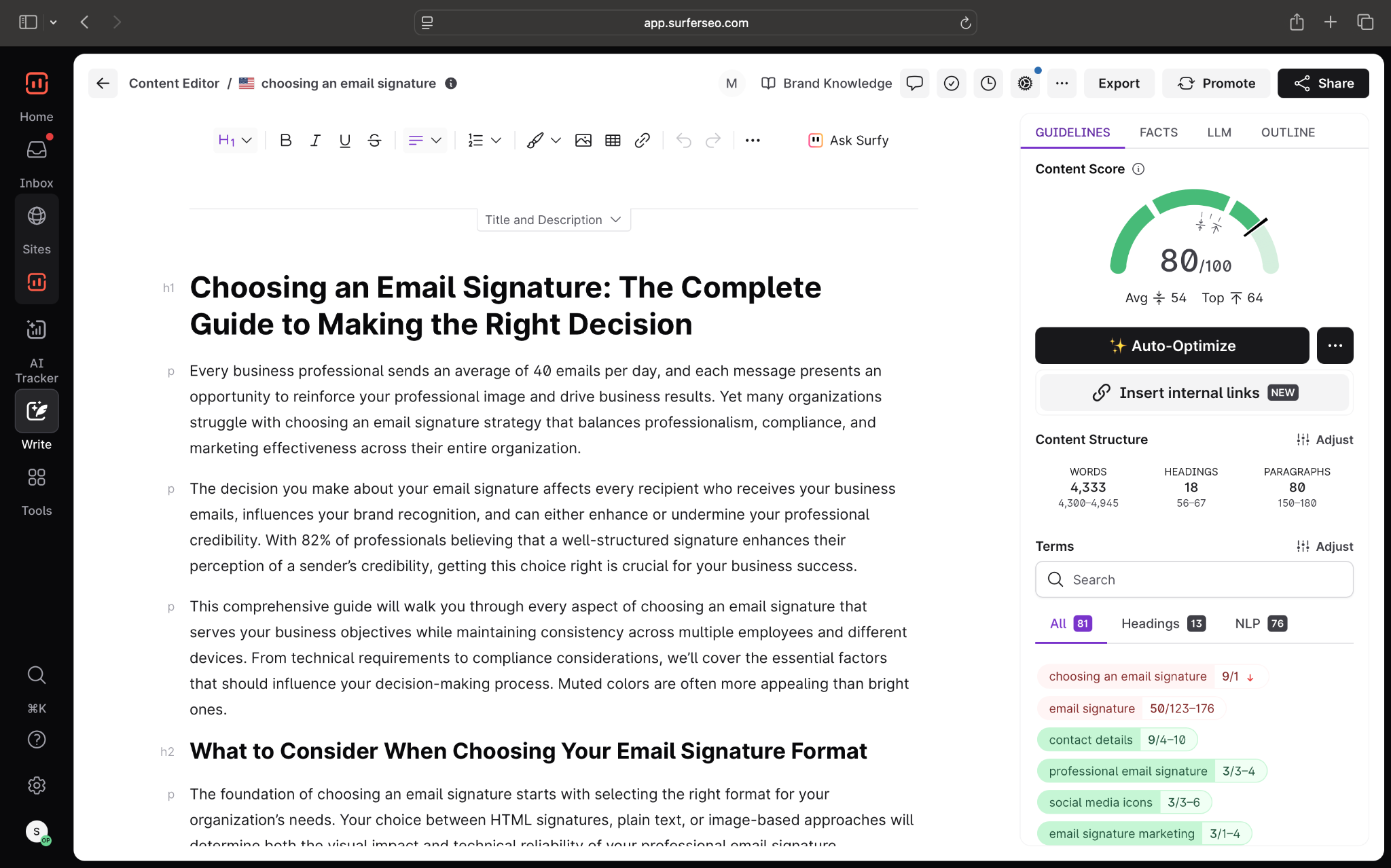
And yes, Google does not penalize AI content, as long as it’s helpful and accurate. What matters is whether your content solves a problem and offers unique value.

Use AI to create a strong starting point, then refine it by adding original research, examples, or commentary. That’s the kind of content people link to.
3. Avoid black hat SEO
Black hat SEO refers to tactics that try to manipulate search engines instead of earning rankings with useful content and legitimate links.
These shortcuts can hurt your page authority, damage your credibility, and even get your pages removed from search results.
Here are some common tactics to avoid:
Hidden text
This means stuffing keywords in invisible text or hiding links with CSS. These tricks are outdated, and search engines penalize them quickly.
Misleading redirects
Showing one page to users and another to search engines (also called cloaking) leads to a poor experience and often results in lost rankings.
Link schemes
When you buy links, spam forums, or get backlinks from low-quality sites, it can backfire. These tricks might work for a short time, but Google is good at spotting them.
If your links look unnatural or come from unrelated pages, they won’t help and could even hurt your rankings.
A good example of how black hat SEO can backfire is what happened with J.C. Penney. Over 2,000 backlinks to their dress pages came from weak, low-quality sites created just for link building.
After a New York Times report exposed it, Google penalized the brand and their keywords dropped from page one to page five.
If you’re trying to improve your page authority, avoid risky shortcuts. Focus instead on building links from relevant, trustworthy sites that contribute to your credibility.
4. Leverage internal linking
Internal links do more than help users navigate your site. They pass authority from one page to another, especially when the linking page already performs well in SERPs.
If a high-authority blog post links to a low-performing one, it transfers some of its value. This helps the second page improve its authority score over time.
I treat internal links as a way to distribute earned authority across my content. It’s especially useful when new content hasn’t built backlinks yet.
Start by identifying your strongest pages. These are the ones already ranking well or attracting backlinks. You can use Google Search Console to spot pages that bring in the most traffic.
Then look for ways to connect them to related pages.
Let’s say your post on “pizza dough techniques” performs well. If you recently published a new guide on “how to bake a pizza at home,” link to it from the older post. The goal is to support your newer content with what’s already working.
But internal linking only helps if it’s done right.
Avoid dumping a bunch of them at the bottom of a post. Instead, add them within the content where they feel natural.
Use clear, descriptive anchor text. If you're linking to a recipe, say “homemade pizza guide” instead of something generic like “click here.” This helps both search engines and readers understand what they’ll find.
To speed this up, I use Surfer’s Insert internal links feature, which automatically suggests internal link opportunities that make sense in context. You can review and approve the suggestions directly in the interface.
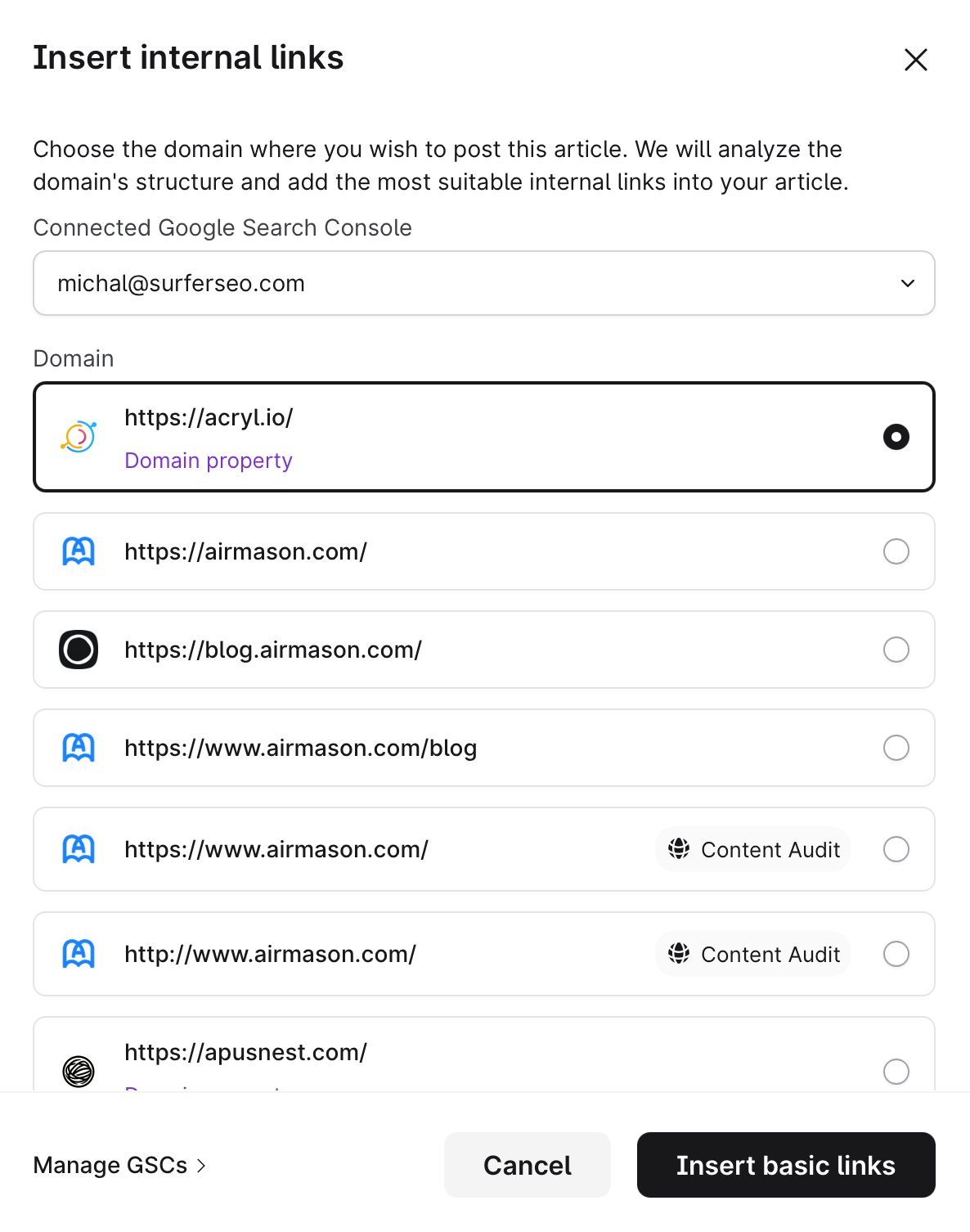
5. Keep your content fresh
Outdated pages lose rankings, even if they once performed well. Search engines prioritize content that’s accurate, up to date, and aligned with what users are searching for now.
That’s why refreshing content matters.
You don’t always need to rewrite a post. Sometimes, small updates can keep it relevant and improve performance. That might mean swapping in newer statistics, updating product mentions, or adjusting a headline to match search intent.
Here’s what I look for when deciding which content needs a refresh:
Industry shifts have made parts of your post outdated: If you’re writing about AI, SEO, or policy changes, things move fast. A post that mentioned third-party cookies or Google updates in 2022 may not reflect how the landscape looks now.
Your data is old: If you’re citing statistics from 2018 or 2019, readers may not trust the content as much. They’re likely comparing your page with others that reference 2024 data.
Your business information has changed: Maybe you’ve added new features, updated pricing, or launched a new service. If your content still reflects the old version, it could cause confusion or missed conversions.
You can find declining pages inside Google Search Console.
- Go to the Performance tab and open the Search Results report.
- Then apply the compare filter (e.g., "Last 28 days vs. Previous 28 days").
- With the Clicks metric enabled, sort by “Clicks difference” to see which pages have lost traffic recently. Those are your best candidates for a content refresh.

What is considered a good page authority score?
There’s no universal benchmark for what counts as a “good” page authority score. Since the scale is logarithmic, moving from 20 to 30 is easier than going from 60 to 70. And the same score can mean very different things depending on your niche.
The best way to interpret page authority is in context. Use it as a comparative metric against pages targeting the same keyword or serving the same intent.
For example, if you’re a SaaS company publishing a pricing guide, check how your page authority stacks up against similar guides from competitors and not against pages from sites like Forbes or HubSpot. Comparing yourself to pages in a different authority tier skews your expectations and strategy.
Focus on the SERPs where you’re actively trying to compete.
If the top-ranking pages average a score of 35 and your page is sitting at 18, that’s a useful signal. It tells you there’s room to build authority through content, internal links, or backlinks.
Instead of chasing a magic number, aim to match or exceed the scores of direct competitors within each SERP. That’s what makes page authority useful. It gives you a realistic benchmark to work from.
Key takeaways
- Page authority is not a Google ranking factor, but it helps predict how likely a specific page is to rank in search engine results.
- A strong backlink profile is one of the biggest drivers of a high page authority score. Focus on quality over quantity when building links.
- Internal linking helps distribute authority across your site. Link from high-authority pages to relevant ones to boost visibility.
- Content freshness matters. Updating older posts with current data and business info can help maintain or improve rankings.
- Use tools to check your page authority and monitor how it compares to similar pages.







